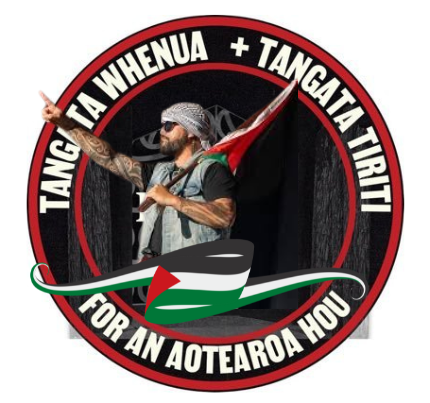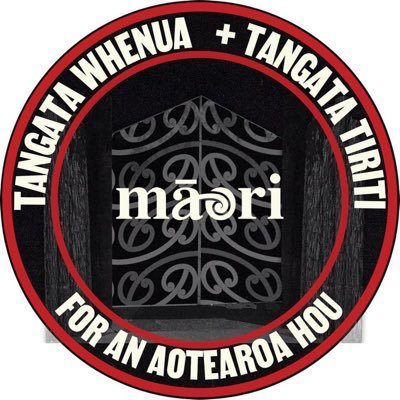6:32 pm on 4 July 2024 Share this
Community and hapū members opposing the Puketītī development, from left, Linda Harris, Moengaroa Tana, Phoenix Tana, Cynthia Matthews, Anthony Williams and Paula Becks. Photo: RNZ / Peter de Graaf
Tensions are rising again at Ōpua in the Bay of Islands, where a council-owned company is planning a housing development on behalf of an overseas owner.
A headland known as Puketītī, next to the main road descending to the port, was occupied in 2020 by hapū Te Roroa ki Ōpua to stop 17 homes being built on land subject to a Treaty claim.
The 24/7 occupation lasted more than a year, with interruptions caused by the Covid-19 pandemic, and ended when a new council was elected in 2022.
Following mediation by Far North mayor Moko Tepania, council-owned company Far North Holdings and representatives of landowner Dong Guo presented a revised plan to a public meeting at Te Rito Marae, near Moerewa, on 22 June.
In the new plan, the number of homes would be reduced to 13 and the hilltop would be left untouched.
Members of the hapū Te Roroa ki Ōpua and community group Save Ōpua’s Soul – the main opponents of the development – left the meeting with the understanding that no work would be carried out until hapū elders had met to discuss the proposal.
On Monday, however, a digger arrived at the site to start clearing vegetation.
Local residents were quick to arrive, forcing the digger driver to stop work for safety reasons.
The same scenario was repeated on Tuesday.
Police were called on both occasions but there were no issues or arrests.
A digger clears vegetation at Puketītī, in Ōpua, earlier this week. Photo: Supplied / Paula Becks
During Tuesday’s call-out, RNZ understands police iwi liaison officers suggested the work be suspended until after the hapū meeting.
Te Roroa ki Ōpua spokesman Anthony “Koots” Williams said the vegetation clearance was a breach of the understanding that work would not start until kaumātua and kuia had met to discuss the proposal.
That meeting was due to take place by Zoom on Thursday evening.
Williams said this week’s actions by Far North Holdings – which sold the land in the first instance and was managing the initial stages of the project – had eroded trust.
“They’ve really broken our talks. We can’t trust them. They brought a digger up here and they cleared the vegetation. It’s trampled our mana. They’ve just gone ahead and done it,” he said.
Williams said it was up to hapū elders to decide on the developer’s proposal.
If they rejected the revised plan, they would also discuss the next steps – including whether the occupation should resume.
Williams’ personal view was that the maunga should be returned in its entirety.
He said Puketītī was the site of a pā built by hapū ancestor Pumuka, and served as a lookout because of its commanding view across the Bay of Islands.
The revised proposal for Puketītī reduces the number of homes to 13 and leaves the top of the hill untouched. Photo: Supplied / Far North Holdings
Williams said the hill had already been significantly reduced in size over the years, and was the last site of cultural significance left in Ōpua.
The area was also subject to a Treaty claim, Wai 49, lodged by the late Sir James Henare in 1988.
In 2020, community members set up a group called Save Ōpua’s Soul (SOS) to fight the development and support hapū.
SOS founder member Paula Becks said it was “bad faith” to bring the digger in so soon after the 22 June meeting.
“At the end of the meeting it was just left that the hapū were going to discuss it and get back to Far North Holdings about whether they would accept this proposition or not, but what happened in the interim is that Far North Holdings has just decided to start work on the hill anyway,” she said.
“This came out of the blue for us so we’re all pretty shocked.”
Becks said the 1.4ha site had been sold without public knowledge under a previous council’s tenure, to someone who did not know there was a Treaty claim on the land.
It was not until the sale went unconditional sale in March 2020 that the hapū and Ōpua community found out about it.
“This has been a long fight and we’re determined to save the hill for hapū, the community and everyone,” she said.
The entrance to the planned development is on Ōpua’s Kellett Street, just off Franklin Street and a stone’s throw from Ōpua School. Photo: RNZ / Peter de Graaf
Far North Holdings chief executive Andy Nock said Puketītī’s cultural and historic significance was first brought to the company’s attention after the land was sold to Dong Guo in 2018.
Guo agreed to refrain from any work until the site’s status had been investigated.
Although Heritage New Zealand found the area was not wāhi tapu, Guo offered to transform part of Puketītī into a lookout for the benefit of mana whenua.
The lookout could include pou and storyboards explaining the headland’s historical and cultural significance, with the design determined by hapū.
Nock provided RNZ with an excerpt from a speech he said was given by Guo’s representative at the 22 June meeting, stating his intention to begin work immediately on the lower part of the site, where railway homes had been located in the past.
Guo also gave his word that the high ground, where the lookout was proposed, would not be touched.
Both Williams and Becks, however, said they left the meeting with the clear impression that no work would take place until after the hapū had met to discuss the proposal.








